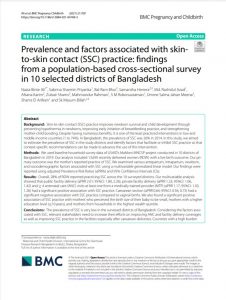
Background
Skin-to-skin contact (SSC) practice improves newborn survival and child development through preventing hypothermia in newborns, improving early initiation of breastfeeding practice, and strengthening mother-child bonding. Despite having numerous benefits, it is one of the least practiced interventions in low and middle-income countries (1 to 74%). In Bangladesh, the prevalence of SSC was 26% in 2014. In this study, we aimed to estimate the prevalence of SSC in the study districts and identify factors that facilitate or inhibit SSC practice so that context-specific recommendations can be made to advance the use of this intervention.
Methods
We used baseline household survey data of USAID’s MaMoni MNCSP project conducted in 10 districts of Bangladesh in 2019. Our analysis included 13,695 recently delivered women (RDW) with a live birth outcome. Our primary outcome was the mother’s reported practice of SSC. We examined various antepartum, intrapartum, newborn, and sociodemographic factors associated with SSC using a multivariable generalized linear model. Our findings were reported using adjusted Prevalence Risk Ratios (aPRRs) and 95% Confidence Intervals (CIs).
Results
Overall, 28% of RDW reported practicing SSC across the 10 surveyed districts. Our multivariable analysis showed that public facility delivery (aPRR 2.01; 95%CI: 1.80, 2.26), private facility delivery (aPRR 1.23; 95%CI: 1.06, 1.42) and ≥ 4 antenatal care (ANC) visits at least one from a medically trained provider (MTP) (aPRR 1.17; 95%CI: 1.03, 1.26) had a significant positive association with SSC practice. Caesarean section (aPRR 0.64; 95%CI: 0.56, 0.73) had a significant negative association with SSC practice compared to vaginal births. We also found a significant positive association of SSC practice with mothers’ who perceived the birth size of their baby to be small, mothers with a higher education level (≥10 years), and mothers from households in the highest wealth quintile.